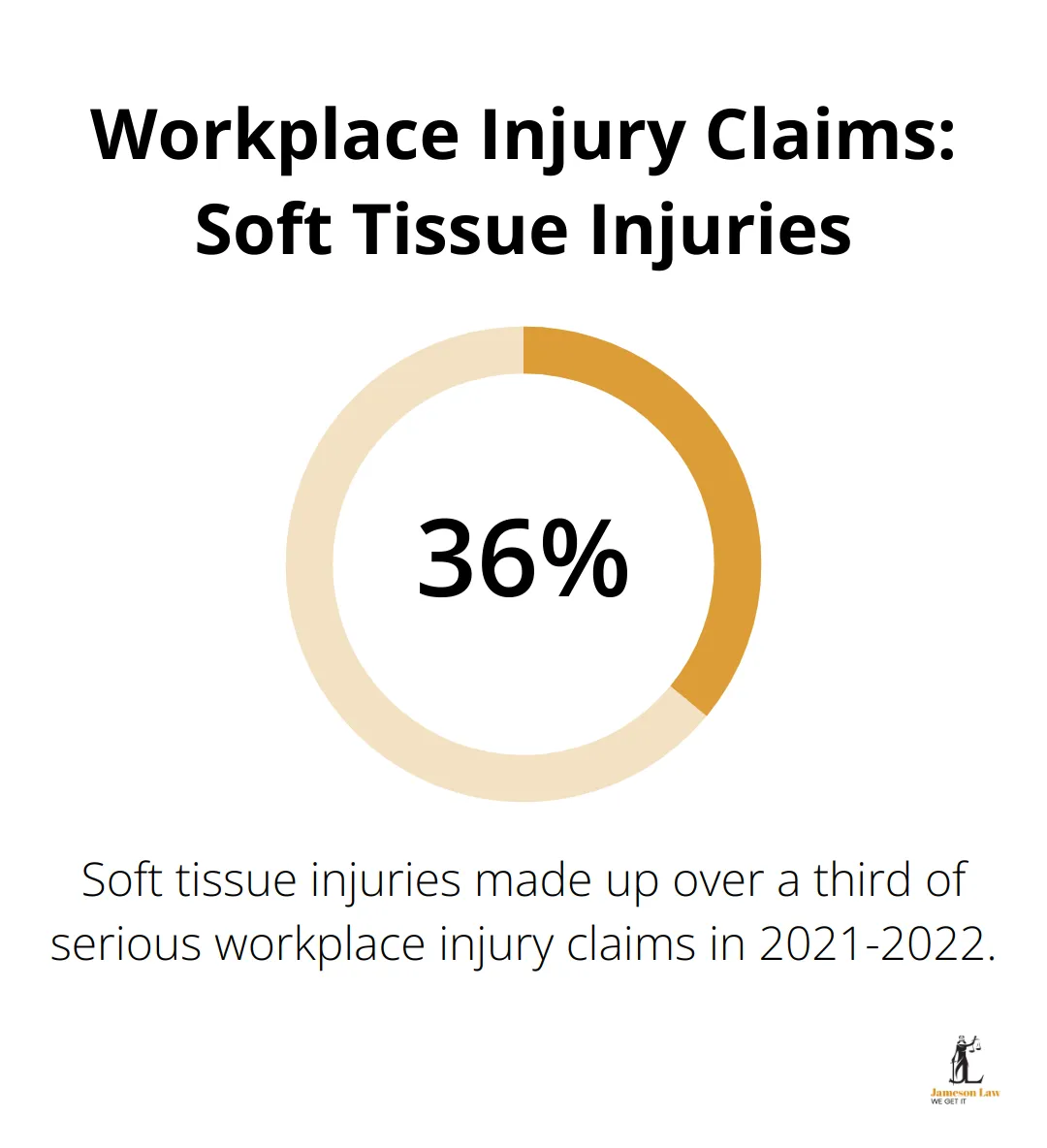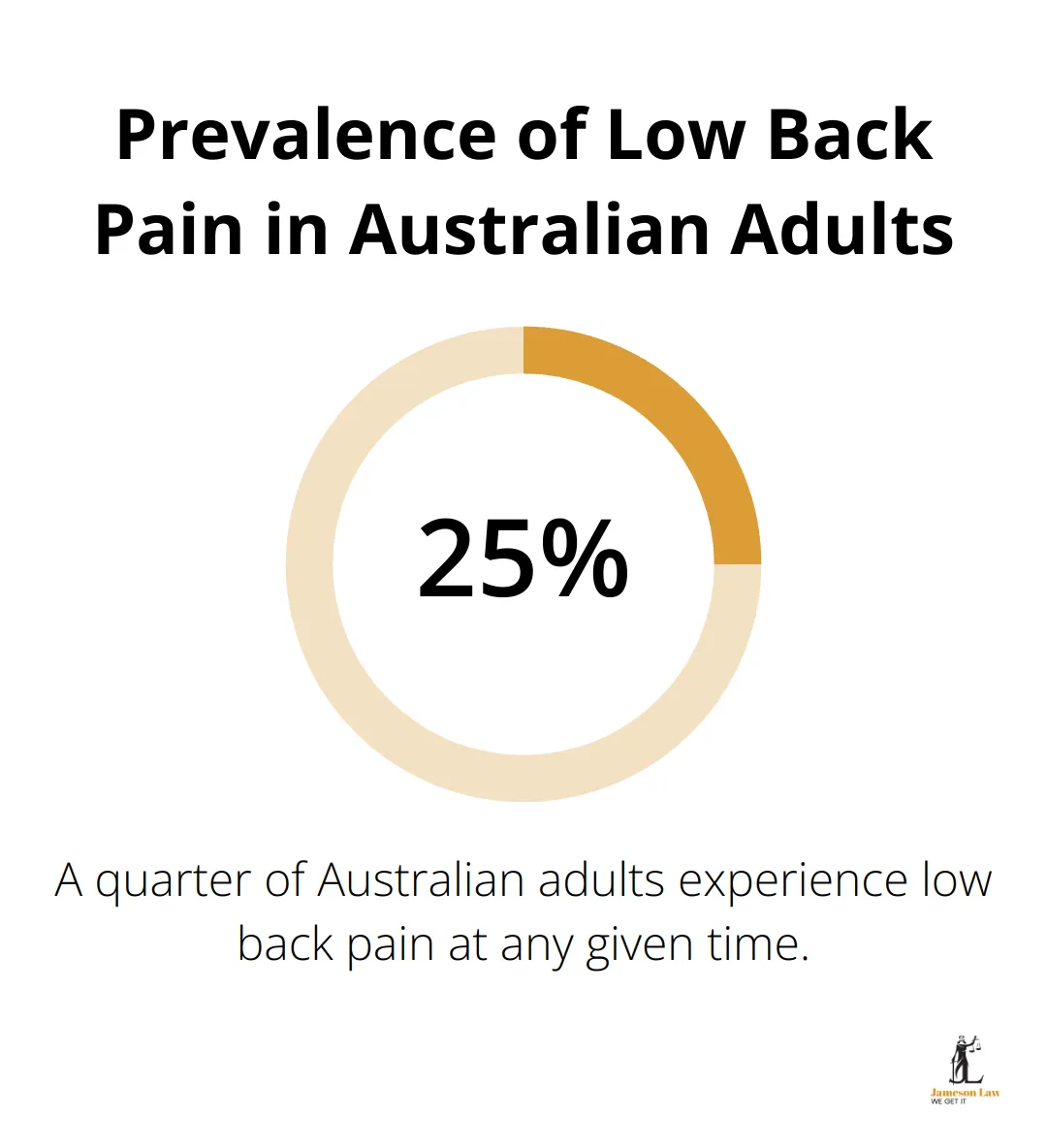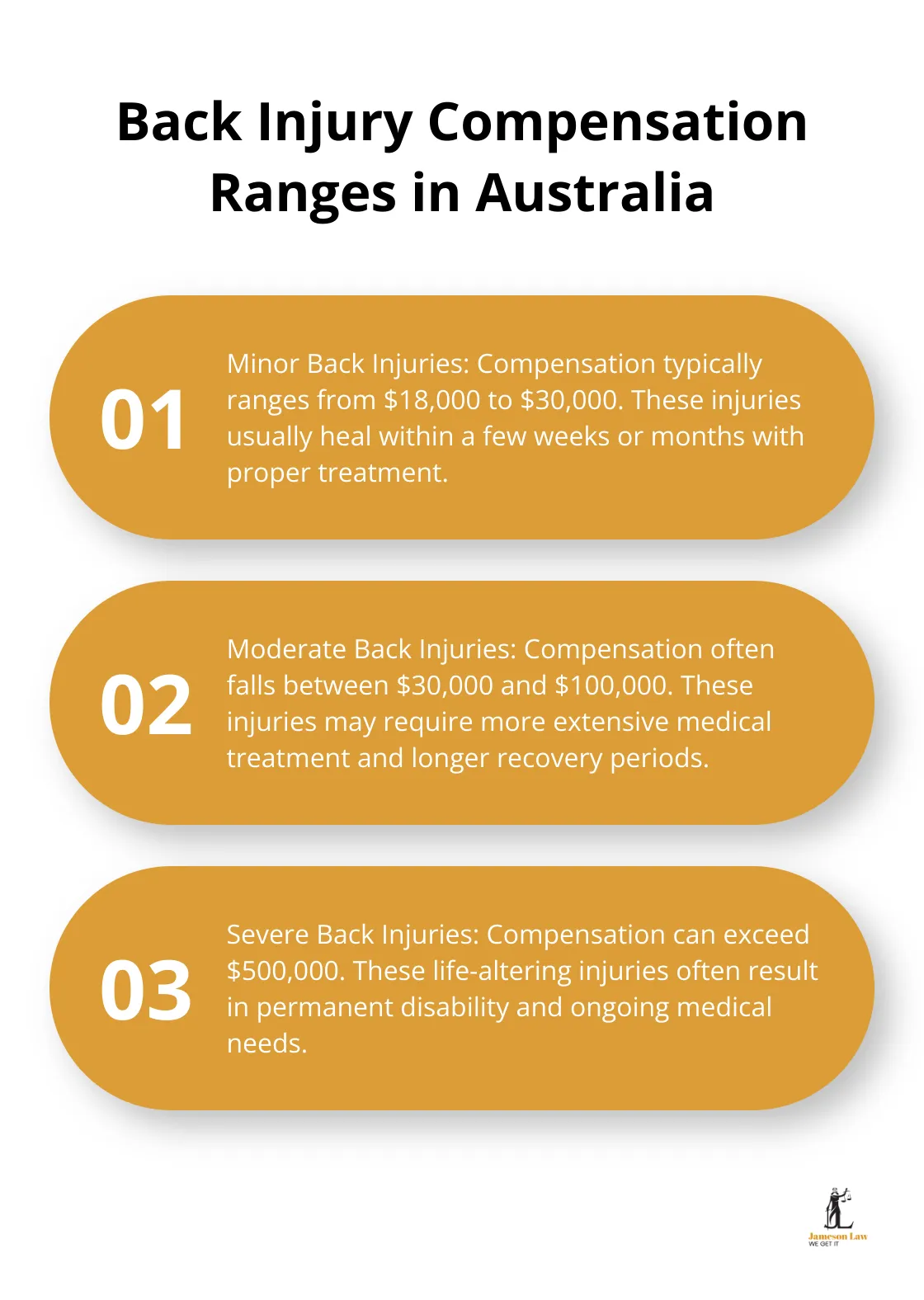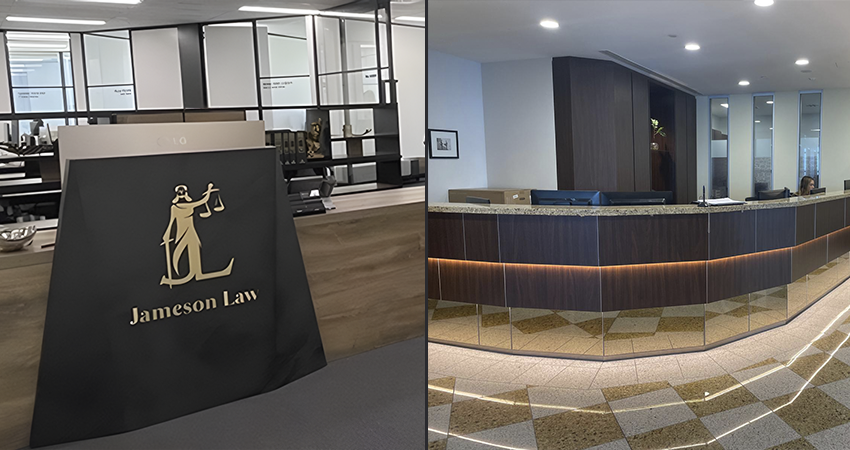Back injuries can be life-altering, affecting your ability to work and enjoy daily activities. Understanding back injury compensation payouts in Australia is crucial for those seeking fair recompense for their suffering.
At Jameson Law, we’ve seen first-hand how proper compensation can make a significant difference in our clients’ lives. This guide will explore the types of back injuries eligible for compensation, factors affecting payout amounts, and average compensation ranges in Australia.
What Back Injuries Qualify for Compensation?
Back injuries can range from mild discomfort to life-altering conditions. In Australia, various types of back injuries may qualify for compensation, depending on their severity and impact on your life.
Soft Tissue Injuries
Soft tissue injuries, such as sprains and strains, are common in workplace accidents and motor vehicle collisions. These injuries affect muscles, ligaments, and tendons in the back. While often less severe than other types of back injuries, they can still cause significant pain and limit mobility.
Safe Work Australia reports that soft tissue injuries accounted for 36.7% of serious workplace injury claims in 2021-2022. These injuries can result in compensation for medical expenses, lost wages, and rehabilitation costs.

Spinal Cord Injuries
Spinal cord injuries are among the most severe back injuries and can lead to partial or complete paralysis. These injuries often result from high-impact accidents, falls from heights, or severe workplace incidents.
According to the AIHW Spinal Cord Injury Statistics (2017-2018), spinal cord injuries are a significant health concern in Australia. Compensation for spinal cord injuries can be substantial, covering lifelong medical care, home modifications, and loss of earning capacity.
Herniated Discs
Herniated discs occur when the soft inner portion of a spinal disc pushes through a crack in the tougher outer casing. This can cause pain, numbness, and weakness in the back and limbs.
Musculoskeletal disorders (MSDs), which include conditions like herniated discs, contributed 12 per cent of Australia’s total burden of disease and injury in 2011. Compensation for herniated discs typically covers medical treatment (including surgery if necessary) and lost income during recovery.
Fractured Vertebrae
Vertebral fractures can occur from severe trauma, such as car accidents or falls. These injuries can be extremely painful and may require extensive medical treatment, including surgery and long-term rehabilitation.
The Australian Spinal Cord Injury Registry (ASCIR) reports health data for all spinal cord injuries managed by spinal cord injury units in Australia. Compensation for fractured vertebrae often includes coverage for immediate medical care, ongoing treatment, and potential long-term disability support.
Now that we’ve covered the types of back injuries eligible for compensation, let’s explore the factors that affect the compensation amounts for these injuries.
What Determines Back Injury Compensation?
Injury Severity and Long-Term Effects
The severity of your back injury plays a primary role in determining compensation. Minor injuries like muscle strains typically result in smaller payouts, while severe injuries such as spinal cord damage can lead to substantial compensation. The Transport Accident Commission reports that the average impairment benefit for spinal injuries in Victoria was $46,700 in 2021-2022 (though this figure can vary significantly based on individual circumstances).
Long-term effects are equally important. If your injury results in permanent disability or chronic pain, you’re likely to receive higher compensation. At any one time in Australia, a quarter of all Australian adults have low back pain. This statistic underscores the potential for long-term impacts from back injuries.

Medical and Rehabilitation Expenses
Your compensation will also factor in both current and future medical expenses. This includes costs for surgeries, medications, physiotherapy, and any necessary medical equipment. However, this represents just a fraction of the potential long-term medical costs for severe back injuries.
Rehabilitation costs are another key component. These may include ongoing physiotherapy, occupational therapy, or even home modifications for severe injuries. The compensation should provide you with the resources needed for optimal recovery and adaptation to any lasting effects of your injury.
Income Loss and Future Earning Capacity
Lost wages due to your injury form a significant part of compensation calculations. This includes both immediate income loss and potential future earnings if your injury affects your ability to work long-term. In 2017-18, 21% of people with back problems were unable to work or were restricted in the type of work they could do (Australian Bureau of Statistics).
For severe injuries that limit your future earning capacity, compensation may include a lump sum to cover this loss. This calculation takes into account factors such as your age, qualifications, and pre-injury earning potential.
Pain and Suffering
Non-economic damages, often referred to as pain and suffering, are also considered in back injury compensation. These damages aim to compensate for the physical pain and emotional distress caused by your injury. While it’s challenging to put a monetary value on these experiences, they form an important part of many compensation claims.
In NSW, the maximum amount for non-economic loss in 2023 is $620,000. However, this maximum is reserved for the most extreme cases, and the actual amount awarded depends on the specific circumstances of your injury.
Age and Pre-Existing Conditions
Your age at the time of injury can influence your compensation. Younger individuals may receive higher payouts due to the longer-term impact on their earning capacity and quality of life. However, this isn’t a hard and fast rule, and each case is assessed individually.
Pre-existing conditions can complicate compensation claims. If you had a pre-existing back condition that was exacerbated by the injury, this will be taken into account. It’s important to provide a clear medical history to ensure fair assessment of your claim.
Understanding these factors can help you navigate the claims process more effectively. However, each case is unique, and the interplay of these elements can be complex. This complexity underscores the value of expert legal guidance in pursuing your back injury compensation claim. Let’s now explore the average compensation amounts for different types of back injuries in Australia.
How Much Can You Expect for Back Injury Compensation?
Minor Back Injuries
Back injury compensation in Australia varies widely based on injury severity and life impact. For minor back injuries like mild sprains or strains, compensation typically ranges from $18,000 to $30,000. These injuries usually heal within a few weeks or months with proper treatment. A worker who suffered a minor back strain from lifting heavy objects at work might receive around $20,000 to cover medical expenses and a short period of lost wages.
Moderate Back Injuries
Moderate back injuries, such as herniated discs or more severe soft tissue damage, often result in compensation between $30,000 and $100,000. These injuries may require more extensive medical treatment and longer recovery periods. A car accident victim with a herniated disc requiring surgery might receive compensation of around $75,000 to cover medical costs, rehabilitation, and lost income during recovery.
Severe Back Injuries
Severe back injuries, including spinal cord damage or multiple disc herniations, can lead to compensation exceeding $500,000. These life-altering injuries often result in permanent disability and ongoing medical needs. For instance, a construction worker who suffered a severe spinal cord injury from a fall might receive over $500,000 to cover lifelong care, lost earning capacity, and pain and suffering.

It’s important to note that these figures are general estimates. Your actual compensation will depend on the specific circumstances of your case. Factors such as the impact on your quality of life, ongoing medical needs, and future earning capacity all play significant roles in determining the final amount.
Notable Australian Back Injury Cases
Several high-profile cases in Australia highlight the potential for substantial compensation in severe back injury claims. In one case, a worker received approximately $100,000 in statutory workers compensation for a back injury.
These cases underscore the importance of thorough documentation and expert legal representation in maximising your compensation. While these examples provide insight into potential compensation amounts, each case is unique. Professional legal advice is essential to understand your specific entitlements and navigate the complex claims process effectively.
Final Thoughts
Back injury compensation payouts in Australia vary based on injury severity, long-term effects, medical expenses, and income loss. These factors significantly influence the final compensation amount, making it essential to understand their impact on your claim. Professional legal advice plays a vital role in navigating the complex landscape of personal injury claims and securing fair compensation for your back injury.
Jameson Law specialises in personal injury claims and offers expertise in back injury cases. Our team of experienced lawyers works on a No Win No Fee basis for personal injury claims, ensuring access to quality legal representation without upfront costs. We guide clients through every step of the process, from initial consultation to final settlement, to protect their rights and maximise their compensation.
Don’t let a back injury derail your life. With the right legal support, you can focus on your recovery while we handle the complexities of your compensation claim. Contact us today to discuss your case and learn how we can help you move forward with confidence.









